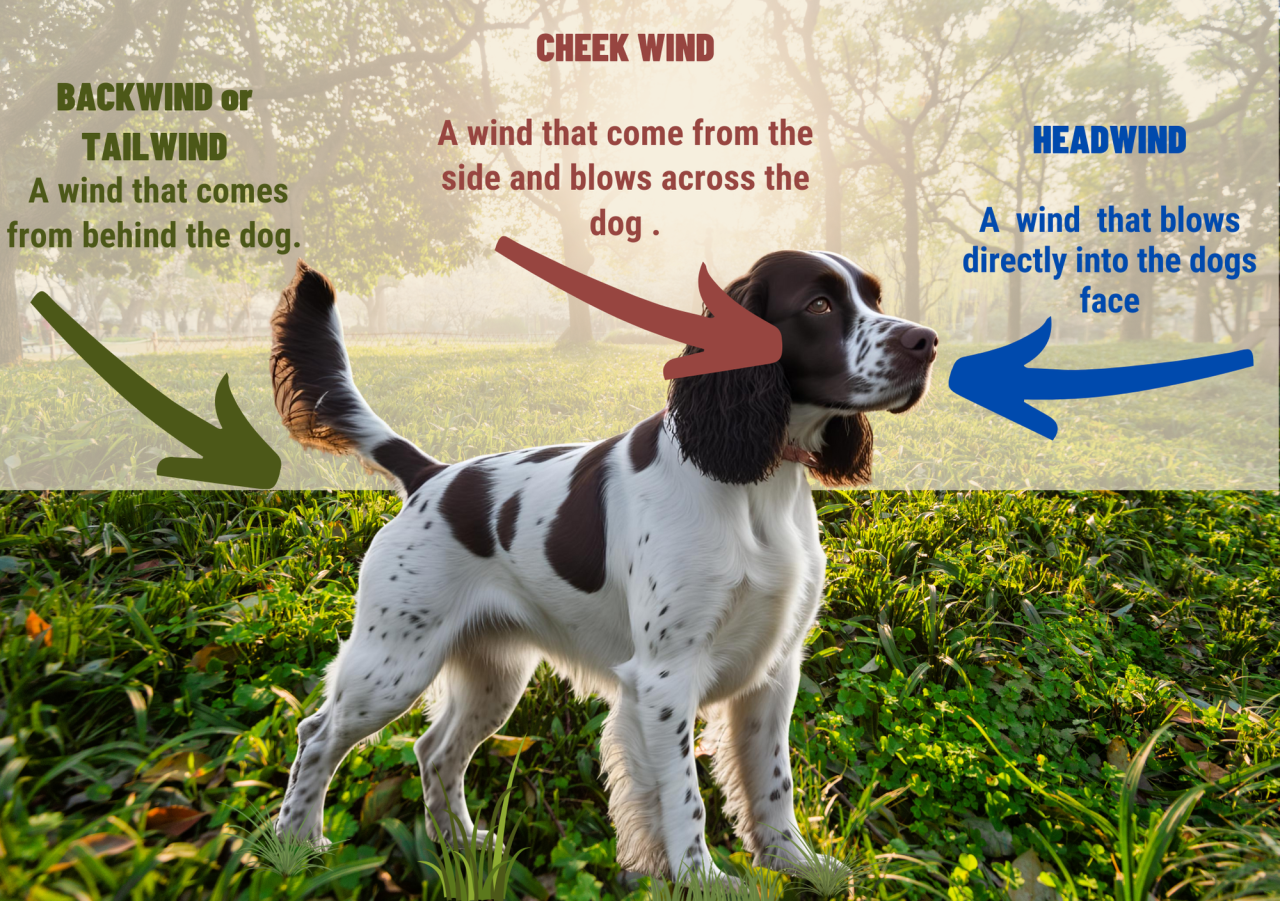Learn how spaniels and HPRs use head, cheek, and tail winds when hunting, and how handlers can adapt

Learn how spaniels and HPRs use head, cheek, and tail winds when hunting, and how handlers can adapt training for every condition.
Hunting With the Wind: Spaniels and HPRs
In the previous blog, we looked at how wind direction influences our dogs’ ability to locate game. This time, let’s go a little deeper and explore how spaniels and HPRs hunt differently in varying wind conditions, and how we as handlers can set them up for success.
Spaniels – The Close Hunting Specialists
Spaniels are bred to hunt close, within gunshot range, pushing through cover and systematically working the ground in front of their handler.
-
Best Wind: A cheek wind (crosswind) is ideal. It allows the dog to quarter across the wind, naturally running into scent cones as they move left and right.
-
Headwind: Dogs will often shorten their pattern, as scent comes straight to them. Some handlers like this, as it keeps the dog tight, but it can make them “sticky,” revisiting areas unnecessarily.
-
Tailwind: The hardest condition. Scent is carried away from the dog, and they may overrun ground or miss game. Good spaniels must learn to hunt on regardless, and clever handlers will adjust their movement to help.
👉 Training tip: Don’t only train in “easy wind.” Teach your spaniel to quarter properly with wind from all directions. This builds confidence and adaptability.
HPRs – The Wider Ranging Game Finders
Hunt, Point, Retrieve breeds are designed to range further than spaniels, using speed and nose to locate game across open ground.
-
Best Wind: HPRs are usually cast to run downwind. From there, they naturally turn back across the handler in a wide cast, sweeping with the wind. This allows them to cut scent cones diagonally and pinpoint game at distance.
-
Headwind: Dogs will run shorter, often tightening up their ground coverage. This can be useful in smaller areas but may reduce efficiency in large ground.
-
Tailwind: As with spaniels, it makes scenting difficult. HPRs will tend to push further forward before turning, and handlers must be prepared to support them.
👉 Training tip: Work on long casts with your HPR, making sure they learn to push out confidently downwind before arcing back. Don’t be afraid to let them range – that’s what they’re bred for.

Understanding the Scent Cone
When game is sitting in cover, scent doesn’t spread evenly in all directions. Instead, it forms a scent cone: a funnel-shaped area carried on the wind. The stronger the wind, the narrower and longer the cone; in lighter wind, the cone is wider but more diffuse.
-
Spaniels working a cheek wind are constantly crossing in and out of scent cones, which is why quartering works so well.
-
HPRs often intercept a cone at distance, locking on and following it upwind to the source before going on point.
-
Tailwinds make scent cones drift away from the dog, which explains why both spaniels and HPRs can find them harder to work in.
Learning to recognise when your dog has entered a scent cone – from a sudden head lift, change of pace, or shift in tail action – is one of the most valuable skills a handler can develop.
Why It Matters
Dogs don’t just “use their nose.” They hunt according to centuries of breeding and their own training. If we only train in one set of conditions (for example, always quartering spaniels into a crosswind), we risk creating dogs that fall apart when conditions change.
By deliberately training in headwinds, tailwinds, and tricky swirling breezes, you help your dog learn resilience and problem-solving.
Practical Training Exercises
-
Spaniels:
-
Quarter in a headwind and reward persistence when they hunt on without obvious scent.
-
Practise casting them into cover with a tailwind so they learn to push forward.
-
Change direction yourself as the wind changes, so your dog learns to adjust.
-
-
HPRs:
-
Cast downwind and reward when the dog turns naturally across you.
-
Work in light cover with a crosswind so they experience scent carrying at distance.
-
Practise in varied terrain – woodland funnels, hedgerows, and open fields – to mimic real shooting conditions.
-
Final Thoughts
Wind is invisible to us, but not to our dogs. By learning how spaniels and HPRs should work it – and by giving them practice in all conditions – we not only improve their efficiency in the field, but also build confidence and teamwork between dog and handler.
Whether you’re handling a close-hunting spaniel or a wide-ranging HPR, remember: train the dog in front of you, in the wind that’s blowing that day.
 Sue Watkins
Sue Watkins 